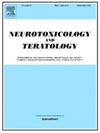大脑中的微(纳米)塑料:神经退行性疾病进展中的表观遗传扰动
IF 2.8
3区 医学
Q3 NEUROSCIENCES
引用次数: 0
摘要
随着全球塑料生产的升级,微(纳米)塑料(MNPs)已成为迫切的生态和生物医学问题。这些污染物越来越多地与神经退行性疾病的发病机制有关。由于它们的纳米级尺寸和表面反应性,MNPs可以穿过血脑屏障,在神经组织中积累。一旦内化,它们会通过诱导氧化应激、线粒体功能障碍和慢性神经炎症(神经退行性进展的关键过程)破坏神经元稳态。线粒体是神经元能量和氧化还原调节的核心,特别脆弱,导致ATP生成受损,ROS升高和促凋亡信号传导。最近的研究表明,MNPs还会诱导表观遗传变化,包括异常的DNA甲基化、组蛋白修饰和非编码rna的失调。这些改变会导致突触不稳定,持续的转录重编程,以及对阿尔茨海默病、帕金森病和肌萎缩性侧索硬化症等疾病的易感性增加。线粒体表观基因组是mnp诱导破坏的重要靶点,为早期诊断和预后提供了潜在的生物标志物,如甲基化的mtDNA和microrna。了解这些表观遗传改变背后的分子机制对于开发实用的诊断工具和治疗方法至关重要。这篇综述提供了mnp诱导的神经变性的全面概述,重点是线粒体和表观遗传破坏。此外,它还探讨了用于检测mnp诱导的表观遗传改变的新兴生物传感技术,强调迫切需要进一步研究以充分了解mnp的神经毒性潜力,并制定预防和治疗策略以减轻其对大脑健康的影响。本文章由计算机程序翻译,如有差异,请以英文原文为准。

Micro(nano)plastics in the brain: Epigenetic perturbations in progression to neurodegenerative diseases
As global plastic production escalates, micro(nano)plastics (MNPs) have become pressing ecological and biomedical concerns. These pollutants are increasingly implicated in the pathogenesis of neurodegenerative diseases. Due to their nanoscale size and surface reactivity, MNPs can cross the blood-brain barrier, accumulating in neural tissues. Once internalized, they disrupt neuronal homeostasis by inducing oxidative stress, mitochondrial dysfunction, and chronic neuroinflammation, key processes in neurodegenerative progression. Mitochondria, central to neuronal energy and redox regulation, are particularly vulnerable, leading to impaired ATP production, elevated ROS, and pro-apoptotic signaling. Recent studies reveal that MNPs also induce epigenetic changes, including aberrant DNA methylation, histone modifications, and dysregulation of non-coding RNAs. These alterations can result in synaptic instability, persistent transcriptional reprogramming, and heightened susceptibility to diseases like Alzheimer's, Parkinson's, and amyotrophic lateral sclerosis. The mitochondrial epigenome is a vital target of MNP-induced disruption, offering potential biomarkers like methylated mtDNA and microRNAs for early diagnosis and prognosis. Understanding the molecular mechanisms behind these epigenetic alterations is essential for developing practical diagnostic tools and therapies. This review provides a comprehensive overview of MNP-induced neurodegeneration, focusing on mitochondrial and epigenetic disruptions. Moreover, it explores emerging biosensing technologies for detecting MNP-induced epigenetic alterations, highlighting the urgent need for further investigation to fully understand the neurotoxic potential of MNPs and develop preventive and therapeutic strategies for mitigating their effects on brain health.
求助全文
通过发布文献求助,成功后即可免费获取论文全文。
去求助
来源期刊
CiteScore
5.60
自引率
10.30%
发文量
48
审稿时长
58 days
期刊介绍:
Neurotoxicology and Teratology provides a forum for publishing new information regarding the effects of chemical and physical agents on the developing, adult or aging nervous system. In this context, the fields of neurotoxicology and teratology include studies of agent-induced alterations of nervous system function, with a focus on behavioral outcomes and their underlying physiological and neurochemical mechanisms. The Journal publishes original, peer-reviewed Research Reports of experimental, clinical, and epidemiological studies that address the neurotoxicity and/or functional teratology of pesticides, solvents, heavy metals, nanomaterials, organometals, industrial compounds, mixtures, drugs of abuse, pharmaceuticals, animal and plant toxins, atmospheric reaction products, and physical agents such as radiation and noise. These reports include traditional mammalian neurotoxicology experiments, human studies, studies using non-mammalian animal models, and mechanistic studies in vivo or in vitro. Special Issues, Reviews, Commentaries, Meeting Reports, and Symposium Papers provide timely updates on areas that have reached a critical point of synthesis, on aspects of a scientific field undergoing rapid change, or on areas that present special methodological or interpretive problems. Theoretical Articles address concepts and potential mechanisms underlying actions of agents of interest in the nervous system. The Journal also publishes Brief Communications that concisely describe a new method, technique, apparatus, or experimental result.

 求助内容:
求助内容: 应助结果提醒方式:
应助结果提醒方式:


